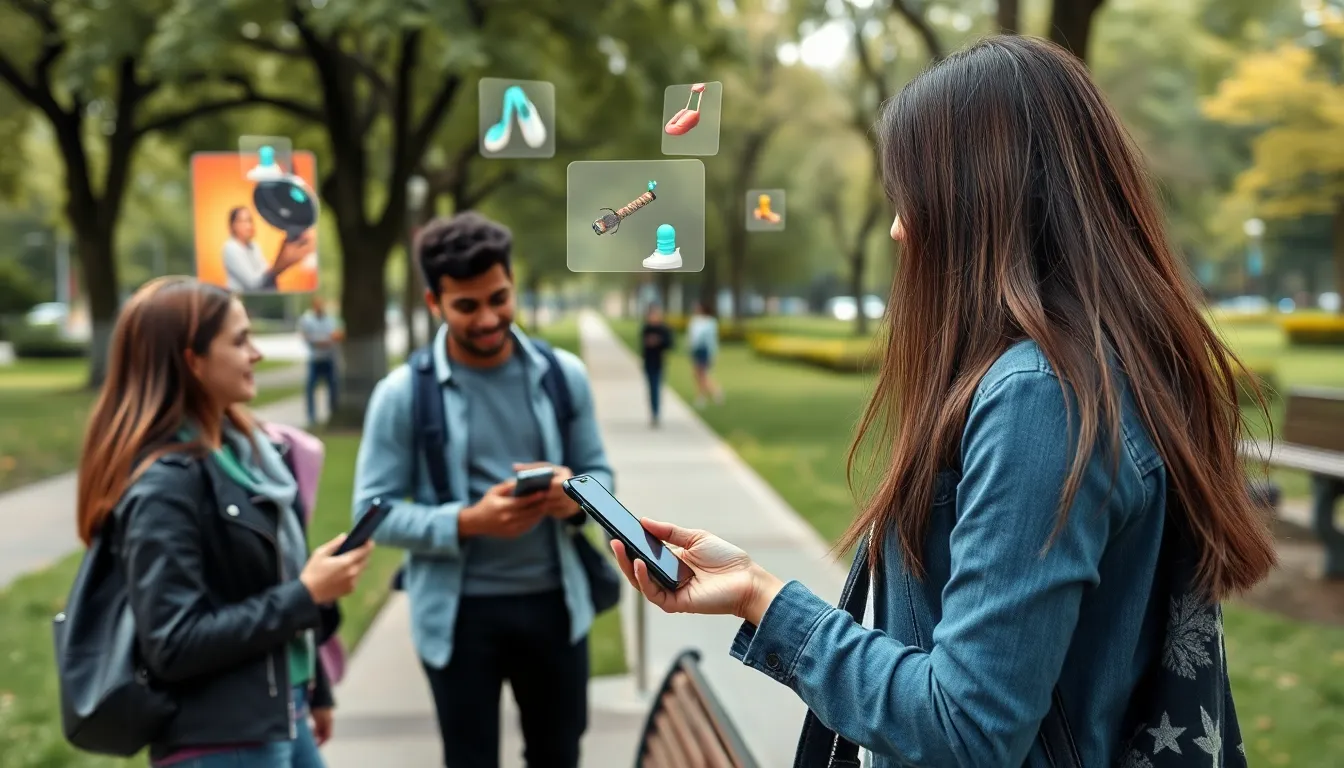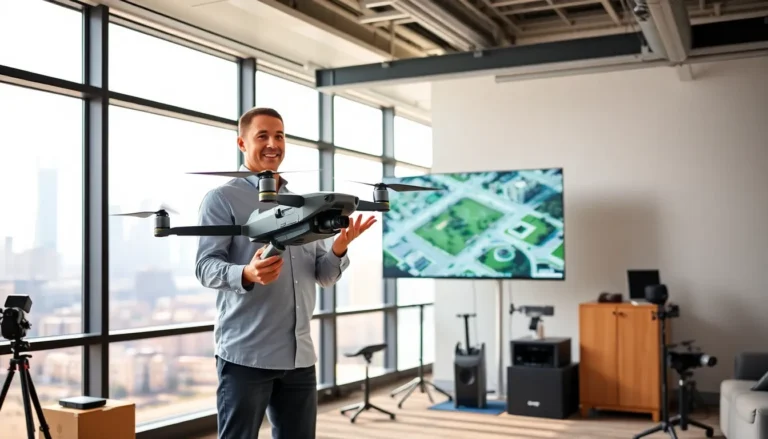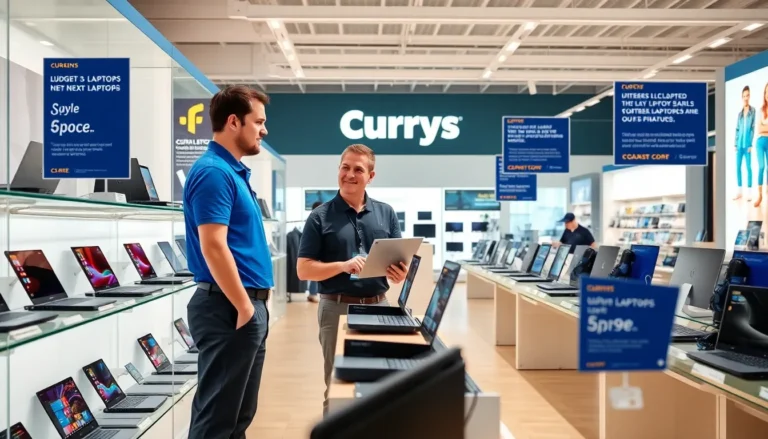Imagine walking down the street and suddenly finding yourself face-to-face with a dancing taco, inviting you to try the latest food truck in town. Welcome to the wild world of augmented reality advertising, where marketing meets magic. This innovative approach isn’t just about flashy graphics; it’s about creating unforgettable experiences that grab attention and spark curiosity.
As brands look for fresh ways to connect with consumers, augmented reality offers a playful twist that turns mundane moments into interactive adventures. From virtual try-ons to immersive storytelling, it’s all about engaging the audience in ways traditional ads can only dream of. So buckle up as we dive into how this tech-savvy trend is transforming advertising and why it might just be the secret sauce your marketing strategy needs.
Table of Contents
ToggleOverview Of Augmented Reality Advertising
Augmented reality advertising integrates digital content with the physical world, transforming how brands interact with consumers. This technology enables advertisers to create immersive experiences that captivate audiences. Businesses utilize AR features, such as virtual try-ons and interactive storytelling, to enhance customer engagement.
Statistics reveal that AR advertising significantly boosts brand recall. Research indicates that 70% of users remember brands that implemented AR in their marketing strategies. Brands leveraging AR benefit from heightened consumer interest and interaction, resulting in increased conversions.
Key platforms, like Instagram and Snapchat, have embraced AR capabilities, allowing users to engage with branded content. These platforms cater to millions of users, making them ideal for AR campaigns. Companies can create shareable content that encourages user participation and promotes organic visibility.
Moreover, the appeal of AR lies in personalization. Users appreciate tailored experiences that resonate with their preferences. Personalized AR ads forge a deeper emotional connection, elevating user experience and loyalty.
The versatility of AR spans various industries, from retail to entertainment. Retailers use AR to offer virtual product demonstrations, increasing consumer confidence in purchase decisions. Meanwhile, entertainment brands create AR experiences that immerse audiences in storytelling, fostering memorable interactions.
Augmented reality advertising represents a transformative strategy for brands aiming to engage today’s digital consumers. By blending the virtual and physical worlds, companies cultivate innovative relationships with their audiences.
Benefits Of Augmented Reality Advertising

Augmented reality advertising offers numerous advantages for brands seeking to connect with consumers effectively.
Enhanced User Engagement
Engagement levels increase with AR advertising due to its interactive nature. Users interact with products in a much more immersive way, leading to memorable experiences. Brands that incorporate AR can create a two-way dialogue with consumers, fostering deeper connections. For instance, virtual try-ons allow potential customers to visualize products before purchasing. This hands-on experience typically results in longer interaction times, driving brand loyalty. Companies leveraging AR maximize user participation, making advertising efforts more effective and more enjoyable.
Improved Brand Recall
Brand recall improves significantly when AR features are present in marketing strategies. Statistics show that 70% of users remember brands that utilize AR in advertising. The unique attributes of AR make messages stand out, creating lasting impressions. Enhanced visual elements capture attention more effectively than static advertisements. Innovative storytelling through AR allows brands to narrate compelling stories that resonate with audiences. Capturing consumer interest not only boosts recognition but also influences purchase decisions and loyalty.
Challenges In Implementing Augmented Reality Advertising
Augmented reality advertising faces notable challenges that can hinder its effectiveness.
Technical Limitations
Technical limitations pose significant obstacles. High-quality AR experiences often require advanced hardware and software capabilities that not all consumers may possess. Compatibility issues arise with various devices and operating systems, leading to inconsistent user experiences. Additionally, developing AR content demands skilled personnel and substantial investments, which can complicate project execution. Fragmentation in AR platforms can also limit the reach of advertisements, as not all consumers utilize the same applications. Efficient optimization for different devices remains crucial for maximizing engagement.
User Acceptance
User acceptance plays a critical role in the success of AR advertising. Many consumers remain skeptical of AR technology, primarily due to privacy concerns and data security. Users require clear value propositions, as they may hesitate to engage with AR content that lacks perceived benefits. Motivation to interact with AR ads often relies on the relevance and appeal of the content presented. Familiarity with the technology influences users’ willingness to embrace AR experiences as well. To increase acceptance, brands must prioritize user education and transparent communication about data usage.
Case Studies Of Successful Augmented Reality Advertising Campaigns
Successful augmented reality advertising campaigns showcase innovative approaches that engage consumers dynamically. Examples highlight how brands adopt AR to enhance user experiences and drive memorable interactions.
Example 1: IKEA Place Campaign
IKEA launched its “IKEA Place” app, enabling users to visualize furniture in their homes virtually. Users can select items and see how they fit in their spaces, improving purchase decisions. This campaign led to a significant increase in customer engagement, evidenced by a 50% rise in customer visits to the app. By integrating AR, IKEA created a personalized shopping experience that resonated with tech-savvy consumers.
Example 2: Pepsi Max Campaign
In 2014, Pepsi Max executed a campaign that transformed a London bus shelter into an interactive AR experience. Passersby witnessed digitally projected scenes, such as aliens and tigers, creating thrilling encounters. This innovative approach generated over 8 million YouTube views, reflecting the campaign’s viral nature. By blending humor with shock, Pepsi Max effectively captured consumer attention and drove brand recall, illustrating the power of immersive advertising experiences.
Future Trends In Augmented Reality Advertising
Augmented reality advertising continues to evolve, shaping the future of the marketing landscape. Content personalization will increasingly dominate, allowing brands to tailor AR experiences based on user preferences and behaviors. This customization leads to deeper consumer engagement.
Innovative technology platforms like Snapchat and Instagram will enhance AR capabilities, providing brands with tools to create more intricate, shareable content. Users will appreciate immersive storytelling that highlights product features in ways traditional advertising cannot replicate.
Data suggests that AR advertising significantly boosts brand recall, with 70% of users retaining information about brands that utilize this technology. This trend indicates a growing reliance on AR for building brand loyalty. Companies engaging in AR campaigns are likely to see improved conversion rates as consumers become more familiar with virtual try-ons and interactive experiences.
Collaboration between brands and AR developers will become crucial. Partnerships can streamline content creation and enhance AR execution across diverse devices. Such collaborations also mitigate challenges related to technical limitations. Transparency regarding data usage will be essential to gain consumer trust among users concerned about privacy.
The exploration of 5G networks presents additional opportunities for AR advertising. Enhanced connectivity can support richer, more seamless experiences. As technology advances, brands that invest in AR will stand out in crowded markets filled with static advertisements.
Emerging trends demonstrate that AR advertising isn’t just a passing phase; it represents a transformative shift in how brands connect with consumers. Notable case studies, like IKEA’s AR app, illustrate remarkable engagement, leading to increased store visits. Overall, marketers embracing AR can create memorable experiences that profoundly impact brand perception and consumer loyalty.
Augmented reality advertising is reshaping the marketing landscape by offering brands unique ways to engage with consumers. Its ability to create immersive and interactive experiences fosters deeper connections and enhances brand loyalty. As technology evolves and consumer familiarity with AR increases, the potential for innovative campaigns will only grow.
Brands that invest in AR advertising can expect not only improved brand recall but also a more engaged audience. By prioritizing user experience and addressing privacy concerns, companies can navigate the challenges of this dynamic medium. Embracing augmented reality is not just a trend; it’s a strategic move that positions brands at the forefront of consumer engagement in a rapidly changing digital world.





